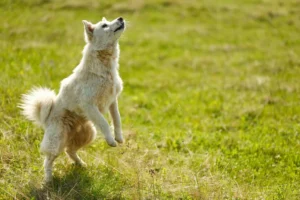Shaking hands isn’t just a polite greeting among humans—it’s also a fun and engaging trick to teach your furry friend!
If you’ve ever struggled with finding ways to bond with your dog or wished you could impress friends with your pup’s impeccable manners, teaching the shake or paw command is a great solution.
As a fellow dog owner, I understand the joy of having a well-behaved and interactive pet, and I’m here to share a step-by-step guide on how to make this a reality for you and your dog.

Why Teach Your Dog to Shake or Give Paw?
Teaching your dog to shake or give paw has a variety of benefits.
Not only does it provide mental stimulation for your dog, but it also strengthens the bond between you two.
Plus, it’s an excellent way to practice obedience training in a fun and engaging manner. Your dog will love the attention and praise they receive, and you’ll love the opportunity to showcase your pup’s adorable new trick to friends and family.
Preparing for the Training Session: What You’ll Need
Before you start teaching your dog the shake or paw command, it’s essential to gather a few items to ensure a successful training session.
First, you’ll need a quiet and comfortable space free of distractions where you and your dog can focus on the task at hand.
Next, gather some small, tasty treats that will serve as positive reinforcement during the training process.
Finally, make sure you’re armed with patience and a positive attitude—after all, your dog will be more receptive to learning when they sense your excitement and encouragement.
With these essentials in place, you’re ready to dive into teaching your pup their new trick!
Teaching the Shake or Paw Trick: A Step-By-Step Guide
Step 1: Get Your Dog’s Attention
Start your training session by getting your dog’s attention. Call their name, and ensure they are focused on you. If they seem distracted, try moving to a quieter location or using a favorite toy to keep them engaged.
Step 2: Introduce the “Shake” or “Paw” Command
With your dog sitting calmly, present your hand with your palm facing up, just in front of their paw. Say the command “shake” or “paw” clearly and confidently. Choose one command and stick with it to avoid confusion.
Step 3: Encourage the Desired Action
If your dog doesn’t lift their paw immediately, gently tap or nudge their leg to encourage the movement. Be patient and give them time to figure out what you want them to do.
You can also try tickling their paws and using a clicker to associate it with a good thing. Immediatelly reward every time there’s a tiny progress in lifting their paw.
Step 4: Reward and Praise
As soon as your dog lifts their paw and places it in your hand, praise them enthusiastically and offer a treat. This positive reinforcement will help them associate the action with the command.
Step 5: Practice and Repeat
Consistency is key when teaching any new trick. Practice the shake or paw command multiple times per session, and hold several sessions throughout the week. Remember to keep training sessions short and fun to maintain your dog’s interest.
Step 6: Gradually Increase Difficulty
Once your dog consistently responds to the command, challenge them by gradually increasing the distance between your hand and their paw, or by asking for their paw while standing up. This will help solidify the behavior and make it more reliable in different situations.
Step 7: Fade Out Treats
Over time, gradually reduce the frequency of treats, but continue to offer verbal praise and affection. This will help your dog transition from relying on treats to performing the trick for praise and attention alone.
Read more: How to Choose Training Toys for Your Dog

Overcoming Common Challenges in Training “Shake/Paw”
Challenge 1: Dog Doesn’t Respond to the Command
If your dog doesn’t respond to the command, try using a more motivating reward, like a higher-value treat or their favorite toy. Make sure you’re saying the command clearly and confidently, and consider using a unique hand signal to help your dog understand what you’re asking for.
Challenge 2: Dog Gets Overexcited and Jumps
Some dogs might get overly excited during training and start jumping. If this happens, calmly ask your dog to sit and wait until they’re calm before resuming the training. Consistently rewarding calm behavior and ignoring jumping will help teach your dog that being calm leads to rewards.
Challenge 3: Dog Offers the Wrong Paw
If your dog consistently offers the wrong paw, try adjusting your hand position or using a gentle touch to guide the correct paw. Be patient, and don’t forget to reward and praise your dog when they offer the correct paw.
Challenge 4: Dog Loses Interest in Training
If your dog loses interest in training, try shortening the sessions and incorporating more playtime. Keep the training fun and engaging by changing the environment, varying the treats, and offering plenty of praise and affection.
Challenge 5: Dog Has Trouble Generalizing the Trick
Some dogs might struggle to perform the trick in different situations or environments. To help your dog generalize the command, practice in various locations and gradually introduce distractions. This will teach your dog to perform the trick reliably, no matter the circumstances.
Encouraging Good Manners: When to Ask for a Shake or Paw
Teaching your dog the shake or paw command isn’t just a fun trick. It’s an excellent opportunity to encourage good manners and build a strong bond between you and your furry friend.
It’s essential to ask for a shake or paw in the right context, such as during a positive interaction or as a way to greet someone new.
I remember when I took Sam, my well-trained dog, to a local dog-friendly event. I was delighted to see Sam politely offer his paw to a fellow dog owner, making a great impression and showcasing his good manners.
Here’s a great video from Zak George on teaching your dog to shake/paw:
FAQs
Can I teach my dog to differentiate between left and right paw?
Yes, you can teach your dog to differentiate between left and right paw by using separate verbal cues or hand signals for each paw and consistently practicing the command.
How long does it usually take to train a dog to shake or give paw?
Training a dog to shake or give paw typically takes a few days to a couple of weeks, depending on the dog’s personality, age, and prior training experience.
Can I teach this trick to a dog with arthritis or mobility issues?
You may be able to teach a modified version of the trick to a dog with arthritis or mobility issues, but always consult your veterinarian first to ensure it won’t cause pain or discomfort for your pet.
How do I prevent my dog from pawing at people or objects?
To prevent your dog from pawing at people or objects, reinforce good behavior with treats and praise, and redirect their attention to an appropriate toy or activity when they start pawing.
Alex, a passionate animal lover, has experience in training and understanding animal behavior. As a proud pet parent to two dogs and three cats, he founded AnimalReport.net to share insights from animal experts and expand his knowledge of the animal kingdom.









